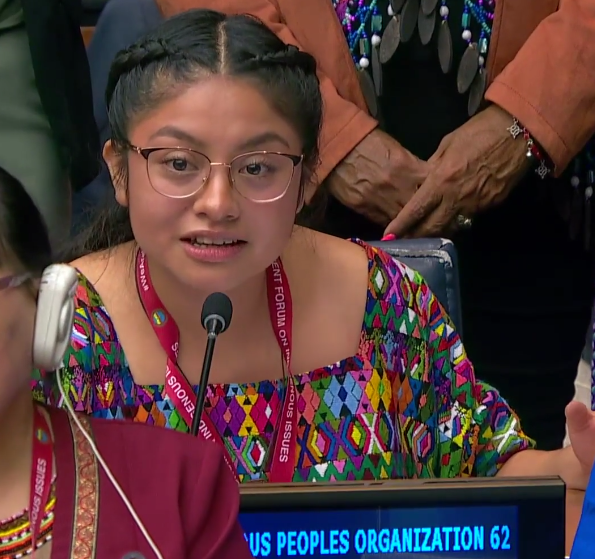CENSORED NEWS
May 13, 2025
Mohawk Nation News 'On-Going Destruction of Turtle Island'
Guatemalan Youth Inspires at U.N. Permanent Forum, 'We are not the end of the road. We are the bridge.'
Guatemalan Youth Inspires at U.N. Permanent Forum, 'We are not the end of the road. We are the bridge.'
By Brenda Norrell, Censored News, May 13, 2025
NEW YORK -- "We are not requesting permission to exist. We are inviting you to walk with us -- hand in hand -- with the wisdom of our ancestors, while we still have time on this earth."
"We are not the end of the road, we are the bridge. We are inspired by our ancestors."
Those are the words of a Guatemalan youth to the United Nations Permanent Forum on Indigenous Issues, representing the Community for Latin America and the Caribbean.
"I am speaking from the global south, and expressing the hope and pain of Indigenous People."
She said this is not an issue of who suffers more, because all are suffering from the systematic injustice, and this must not be a competition for who is suffering most.
This Forum, she said, is not for some sort of prize, but was forged by generations of resistance. It is not to ensure a future for a small few -- but it is for the dignity for many, and reaching this point has not been easy.
"Many voices have been silenced by borders, by poverty, and simply forgotten."
Financing should be transformative, she said. It is not important to sustain what has always been there, but it is important to invest in those who are autonomous with community roots.
"We are not financing to see more reports, we are financing to see lives being transformed."
"We are not the end of the road. We are the bridge. We are inspired by our ancestors."
She urged those gathered to encourage youth leadership that is innovative.
"We are not requesting permission to exist. We are inviting you to walk with us, hand in hand, with the wisdom of our ancestors, while we still have time on this earth."
She is among the young emerging voices at the United Nations Permanent Forum on Indigenous Issues, and delivered a collective statement from the Community for Latin America and the Caribbean.
Copyright Censored News. Censored News original series.
May 12, 2025
Indonesia Accused of Human Rights Crimes at the U.N. Permanent Forum on Indigenous Issues
 |
| Tgk Fajri describes human rights crimes by Indonesia's government at the U.N. Permanent Forum on Indigenous Issues 2025. Screenshot by Censored News. |
Indonesia Accused of Human Rights Crimes at the U.N. Permanent Forum on Indigenous Issues
By Brenda Norrell, Censored News, May 11, 2025
NEW YORK -- In the talk-polite world of the United Nations, Indigenous representatives for the people of Aceh, West Papua, and Maluku delivered a fiery speech, and described the human rights abuses by Indonesia's government.
The delegation also had their signs taken away by United Nations security, and were told not to offend anyone at the U.N. Permanent Forum on Indigenous Issues in New York.
Rights of Nature Advocates Silenced at United Nations
 |
| The High-Level meeting of the UN’s Harmony with Nature and Living Well Programme Silenced International Rights of Nature Delegates. |
“A Slap in the Face” — Rights of Nature Advocates Silenced at the United Nations
“They want this to fail” says former UN program head
By Community Environmental Legal Defense Fund
NEW YORK — Dozens of activists for the rights of nature who traveled to the United Nations to participate in a high-level meeting were unexpectedly barred from speaking on April 22nd, Earth Day, due to a supposed “security breach.”
The attendees, each of whom was personally invited by the Bolivian Foreign Minister, had previously been cleared by UN security personnel and issued access passes. Many had traveled thousands of miles — coming from Brazil, Poland, Canada, the UK, Germany, Netherlands, France, Ecuador, Peru, Mexico, Chile, Bolivia, Nicaragua, and Colombia — to attend the meeting.
May 11, 2025
Indigenous Youth to U.N. -- Mexico's Desert is a Life Giver, Now Exploited for Lithium
Indigenous Youth to U.N. -- Mexico's Desert is a Life Giver, Now Exploited for Lithium
"They say there is nothing in the desert, but we are in the desert, and we have sowed life there."
By Brenda Norrell, Censored News, May 11, 2025
NEW YORK -- An Indigenous youth from Mexico describes the beauty of life on the land when the rains come, and how the World Bank and the international financial system exploit Indigenous Peoples, pushing them off their land for lithium and cattle industries.
"I was raised in Mexico, in a land where people say nothing grows, a semi-desert."
"The rains when they do come show us the power of the cycle of life," an Indigenous youth told the United Nations Permanent Forum on Indigenous Issues.


